云南鱼类名录
- 格式:docx
- 大小:26.40 KB
- 文档页数:10
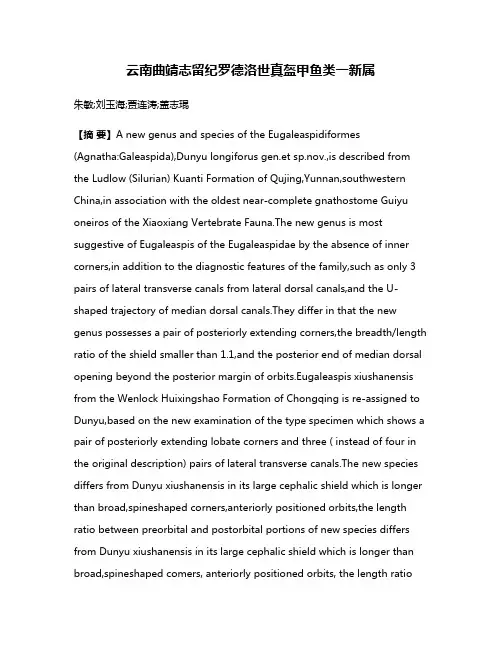
云南曲靖志留纪罗德洛世真盔甲鱼类一新属朱敏;刘玉海;贾连涛;盖志琨【摘要】A new genus and species of the Eugaleaspidiformes (Agnatha:Galeaspida),Dunyu longiforus gen.et sp.nov.,is described from the Ludlow (Silurian) Kuanti Formation of Qujing,Yunnan,southwestern China,in association with the oldest near-complete gnathostome Guiyu oneiros of the Xiaoxiang Vertebrate Fauna.The new genus is most suggestive of Eugaleaspis of the Eugaleaspidae by the absence of inner corners,in addition to the diagnostic features of the family,such as only 3 pairs of lateral transverse canals from lateral dorsal canals,and the U-shaped trajectory of median dorsal canals.They differ in that the new genus possesses a pair of posteriorly extending corners,the breadth/length ratio of the shield smaller than 1.1,and the posterior end of median dorsal opening beyond the posterior margin of orbits.Eugaleaspis xiushanensis from the Wenlock Huixingshao Formation of Chongqing is re-assigned to Dunyu,based on the new examination of the type specimen which shows a pair of posteriorly extending lobate corners and three ( instead of four in the original description) pairs of lateral transverse canals.The new species differs from Dunyu xiushanensis in its large cephalic shield which is longer than broad,spineshaped corners,anteriorly positioned orbits,the length ratio between preorbital and postorbital portions of new species differs from Dunyu xiushanensis in its large cephalic shield which is longer than broad,spineshaped comers, anteriorly positioned orbits, the length ratiobetween preorbital and postorbital porlions of the shield less than 0.75, and large polygonal, flat-topping tubercles exceeding 2.0 mm in length.%记述了云南曲靖潇湘区关底组(志留系罗德洛统)真盔甲鱼类一新属、新种——长孔盾鱼(Dunyu longiforus gen.et sp.nov.),丰富了以梦幻鬼鱼为代表的潇湘脊椎动物群的组成.该新属具真盔甲鱼科的鉴别特征:后眶上管和中背管二者连续过渡,后端两侧辏合呈“U”字形,侧背管仅发出3条侧横管.新属内角缺如,这一特征过去在真盔甲鱼科中仅见于真盔甲鱼属.新属区别于真盔甲鱼属的主要特征有:角向后方延伸,呈棘状或叶状;头甲最宽处位于角末端之前,宽长比小于1.1;中背孔末端超越眶孔后缘连线.基于对秀山真盔甲鱼头甲标本的重新观察,将秀山真盔甲鱼归入盾鱼属.新种区别于秀山盾鱼(Dunyu xiushanensis)的特征有:个体较大,头甲长大于宽;角呈棘状;眶孔位置相对靠前,头甲眶前区与眶后区的长度之比小于0.75;多边形崮状瘤点,较大,长可超过2 mm.【期刊名称】《古脊椎动物学报》【年(卷),期】2012(050)001【总页数】7页(P1-7)【关键词】云南曲靖;志留纪;盔甲鱼类;真盔甲鱼科;新属【作者】朱敏;刘玉海;贾连涛;盖志琨【作者单位】中国科学院古脊椎动物与古人类研究所,脊椎动物进化系统学重点实验室北京 100044;中国科学院古脊椎动物与古人类研究所,脊椎动物进化系统学重点实验室北京 100044;中国科学院古脊椎动物与古人类研究所,脊椎动物进化系统学重点实验室北京 100044;中国科学院古脊椎动物与古人类研究所,脊椎动物进化系统学重点实验室北京 100044【正文语种】中文【中图分类】Q915.861The Xiaoxiang Fauna(Zhu et al.,2009),characterized by the early diversification of gnathostomes or jawed vertebrates(Qu et al.,2010),is distributed in the Qujing area,Yunnan,southwestern China.In addition to the oldest near-complete bony fish Guiyu oneiros(Zhu et al.,2009;Qiao and Zhu,2010),the Xiaoxiang Fauna or the Kuanti vertebrate assemblage(Zhao and Zhu,2010)includes agnathans,placoderms,acanthodians and other osteichthyans under study.Here we describe a complete cephalic shield which represents a new form of the Eugaleaspidiformes(Agnatha:Galeaspida),and provides new data on the morphology and taxonomy of the group(Liu,1965,1975;Halstead et al.,1979;Janvier,1984;Pan,1992;Zhu,1992;Gai and Zhu,2005;Gai et al.,2005,2011;Zhu and Gai,2006).EtymologyFrom dun(Chinese Pinyin),meaning shield,and yu(Chinese Pinyin),meaning fish.Type speciesDunyu longiforus sp.nov.DiagnosisSmall-to medium-sized cephalic shield with its maximum breadth at a level anterior to corner apex,the breadth/length ratio smaller than 1.1;median dorsal opening extending posteriorly beyond orbits;corner extending posteriorly,spine-shaped or lobate;no inner corner;median dorsal canal joining smoothly posterior supraorbital canal at level of pineal organ,and converging posteriorly with opposite one to form U-shapedtrajectory;only 3 lateral transverse canals extending from lateral dorsal canal;6 pairs of branchial fossae;strong size variation of polygonal,flat-topping tubercles;dermal ring encircling median dorsal opening and orbital openings.RemarksEugaleaspis xiushanensis(Liu,1983)was described from the Huixingshao Formation(early Wenlock,Silurian)of Xiushan,Chongqing,and used to represent the earliest occurrence of the genus Eugaleaspis(Liu,1965,1975).By comparison,the type species(Eugaleaspis changi)and the other referred species(E.xujiachongensis,E.lianhuashanensis)were exclusively known from the Lower Devonian(Liu Y H,1965,1975;Liu S F,1986).The re-examination of the holotype of Eugaleaspis xiushanensis(IVPP V 6793.1)suggests that this assignment is weakly supported.Unlike Eugaleaspis changi and E.xujiachongensis,in which the corner extends posterolaterally,the cephalic shield is obviously broader thanlong(breadth/length ratio larger than 1.4),and the posterior end of median dorsal opening anterior to the level of the posterior margin of orbits,E.xiushanensis has a pair of posteriorly extending corners,the cephalic shield with its breadth/length ratio smaller than 1.1,and the median dorsal opening which is more posteriorly extended.In all these regards,E.xiushanensis is more suggestive of Dunyu longiforussp.nov.than the Devonian Eugaleaspis species,and is thus re-assigned to the new genus Dunyu.EtymologyFrom longi(Latin),long,forus(Latin),opening,in reference to the long slit-like median dorsal opening.HolotypeIVPP(Institute of Vertebrate Paleontology and Paleoanthropogy,Beijing)V 17681,a complete cephalic shield.Locality and horizonLate Ludlow,Silurian,Kuanti Formation;Qujing,Yunnan,China.DiagnosisMedium-sized cephalic shield with maximum length of 85.0 mm and maximum width of 78.0 mm;corner spine-shaped;orbits anteriorly positioned,with length ratio between preoribtal and postorbital portions of shield less than 0.75;third lateral transverse canal with dichotomous end;large polygonal,flat-topping tubercles with length over 2.0 mm. DescriptionThe type specimen(IVPP V 17681)is a three-dimensionally preserved cephalic shield,with few endoskeletal elements attached.The shield has its maximum length of 85 mm,the midline length of 66 mm,and the maximum breadth of 78 mm,with a size approaching Eugaleaspis xujiachongensis(Liu,1975).The breadth/length ratio of the cephalic shield is about 0.92,being distinct from those in Eugaleaspis changi andE.xujiachongensis,which are about 1.45 and 1.49 respectively.A pair of spine-shaped corners(c,Fig.1 )extends posteriorly,and leaves the maximum breadth of the shield at a level anterior to the corner apex as in Yunnanogaleaspis(Pan and Wang,1980).By comparison,Eugaleaspis is characterized by its posterolaterally extending corners which leave the maximum breadth of the shield at a level of the corner apex.In dorsal view,the cephalic shield is gently arched to form a domed structure with its highest point at the middle of the posterior margin.The relatively large orbital openings(orb,Fig.1 A)are oval in shape,with theirmaximum length up to 10 mm,and are anteriorly positioned.If we use the middle of the orbital opening as a reference point and take no account of corners,the preorbital and postorbital portions of the cephalic shield are about 28.0 mm and 38.0 mm in length respectively.The length ratio between preoribtal and postorbital portions is about 0.74.In Eugaleaspis changi and E.xujiachongensis,this ratio is more than 0.9.The median dorsal opening(md.o,Fig.1 A,D,E)is longitudinal slit-like as in other eugaleaspids.Its length is about 30.5 mm,whereas its width ranges from 1.6 to 2.5 mm,corresponding to subparallel or slightly concave lateral margins.The median dorsal opening extends posteriorly past the level of orbits.In other eugaleaspids(excluding Eugaleaspis xiushanensis),the posterior end of the median dorsal opening is anterior to the posterior end of the orbital opening.The median dorsal opening is encircled by a dermal ring-like structure(ri,Fig.1 D),which bears anteriorly-tapering spine-like ridges(spi,Fig.1 D)along its medial surface,suggesting the water flow through it.The similar dermal ring encircling the orbital opening bears a smooth surface medially.The pineal opening(pi,Fig.1 A,D,E)is situated immediately behind the median dorsal opening.It is round and relatively large with a diameter of 2.0 mm.The well-preserved sensory canal system displays a unique eugaleaspid pattern(LiuY H,1986;Zhu,1992).The anterior supraorbital canal(soc1,Fig.1 E)runs from the anterior margin of the cephalic shield,and does not connect with the posterior supraorbital canal(soc2,Fig.1 E).The median dorsal canal(mdc,Fig.1 E)joins smoothly the posterior supraorbital canalat the level of pineal opening,and posteriorly converges with the opposite one to form a U-shaped trajectory.Only one dorsalcommissure(dcm,Fig.1 E)is present to connect the median dorsal and lateral dorsal canals.Three lateral transverse canals(ltc1-3,Fig.1 E)extend laterally from the lateral dorsal canal.The third lateral transverse canal(ltc3,Fig.1 E)bears a dichotomous end.The dorsal part of the cephalic shield is flexed ventrally to form a ventral rim(vr,Fig.1 B),which encloses a large pear-shaped cavity for the oralobranchial chamber,the oral chamber(or.c,Fig.1 B)anteriorly and the branchial chamber(br.c,Fig.1 B)posteriorly.The ventral rim protrudes posteriorly to form the base of corner,and medially to form a short rod enclosing the trunk of the body.Starting from the oral margin,the ventral rim gets broader till the boundary between the oral and branchial chambers.In the branchial region,the ventral rim is narrowest at the level of the second branchial fossa,and gradually becomes wider to the levelof the last branchial fossa.The part of the ventral rim contributing to branchial openings is very narrow,in contrast to the condition in Eugaleaspis xujiachongensis(Liu,1975,fig.3).Along the margin of the branchial chamber,six notches for the external branchial opening(br.o1-6,Fig.1 B)are discernable as in other eugaleaspidiforms.Few endoskeletal elements,including an arching line immediately behind the dermal oral margin(endo,Fig.1 B)and some at the postbranchial region(endo,Fig.1A-C),are preserved in the holotype.The endoskeletal elements in postbranchial region suggest that the oralobranchial chamber is probablyclosed by a postbranchial wall as in Changxingaspis andMeishanaspis(Wang,1991).The exoskeleton is ornamented with closely set,polygonal,flat-topping tubercles.The tubercles are tesserae-like in surface view,but each of them is basally continuous with the neighboring tubercles,corroborated by fragmentary sections in the shield.The tubercles show strong size and shape variation in different regions of the cephalic shield.Dorsally,on the portion between the lateral dorsal canals or around the median dorsal opening,the tubercles are relatively large with the maximum length exceeding 2 mm(about 80 tubercles per square centimeter,Fig.1 D).By comparison,the tubercles on the corner or its neighboring areas aresmall(about 600 tubercles per square centimeter,Fig.1 C).Ventrally,the tubercles on the part of the ventral rim lateral to the oral chamber are evidently larger than those behind it.The similar size variation of tuberclesis also present in Eugaleaspis changi(personal observation).The tubercles,either large or small,are usually irregular pentagonal in shape,however,the tubercles close to the median dorsal opening and orbital openingstend to be elongated,with their longitudinal axis perpendicular to the dermal ring.Sometimes,the closely set tubercles are interrupted by the sensory canals which run through between exo-and endoskeleton.Among 4 species referred to Eugaleaspis,E.lianhuashanensis(Liu S F,1986)from the Lower Devonian of Guangxi is poorly known due to the specimen preservation.Among the rest,E.xiushanensis from the Huixingshao Formation(early Wenlock,Silurian)of Xiushan,Chongqing(Liu,1983)was distinguishable from the other Eugaleaspis species(as well as from the eugaleaspid genera)in its assumed 4 pairs of lateral transverse canals running from the lateral dorsal canal.However,Liu Y H(1986)suggested only 3 pairs of lateral transverse canals inE.xiushanensis yet provided no illustration or interpretation.Our new examination of the holotype(IVPP V 6793.1)of E.xiushanensis(Fig.2 B,3)not only confirms Liu Y H(1986)'s observation on the sensory canal system,but also shows the striking differences between E.xiushanensis and the Devonian Eugaleaspis species,such as the corner projecting direction and the breadth/length ratio of the shield.Liu(1983)restored the corners in V 6793.1 following the condition in Eugaleaspis changi andE.xujiachongensis.The scrutiny on V 6793.1,however,shows that more parts of the cephalic shield are present behind the assumed‘corners’(Liu,1983).On the right side of the cephalic shield(left side on the external mould),the part behind the assumed‘corner’exhibits a lobate shape,although it is not completely preserved.Based on our revisedrestoration(Fig.2 B),E.xiushanensis bears a corner,which is distinguishable from that in the Devonian Eugaleaspis species.With posteriorly extending corners,the cephalic shield of E.xiushanensis looks obviously narrower than that of other Eugaleaspis species.In this case,if we still assign E.xiushanensis to Eugaleaspis,the diagnosis of the genus will be modified to a large extent.Alternatively,E.xiushanensis could be excluded from Eugaleaspis to keep the original diagnosis(Liu,1965,1980).The discovery of the new form from the Xiaoxiang Vertebrate Fauna might provide new thread into this taxonomic puzzle.In overall,the new form resembles E.xiushanensis in many aspects,such as the posteriorly extending corner and the breadth/length ratio of cephalic shield less than 1.1.However,compared with E.xiushanensis,the new form morphologically deviates more from the Devonian Eugaleaspis species.Ifwe continue to assign this new form to Eugaleaspis,the diagnosis of the genus has to be further modified to cover a larger morphospace(e.g.the breadth/length ratio of cephalic shield ranging from 0.9 to 1.5).In this case,a new genus(Dunyu gen.nov.)encompassing the new form andE.xiushanensis is a reasonable treatment to maintain the diagnostic stability of Eugaleaspis,which is the first genus of the Galeaspida described in the literature(Liu,1965,1980).Among the Eugaleaspidae(Liu,1965,1980),Dunyu is more closely related to Eugaleaspis than either to other genera(Pan and Wang,1980;Zhu,1992)by the absence of inner corners.AcknowledgementsWe thank C.H.Xiong for specimen preparation,J.Zhang for field work,and B.Choo for English improvement.Gai Z K,Donoghue P C J,Zhu M et al.,2011.Fossil jawless fish from China foreshadows early jawed vertebrate anatomy.Nature,476:324-327 Gai Z K(盖志琨),Zhu M(朱敏),2005.A new genus ofeugaleaspids(Galeaspida,Agnatha)from the Silurian of Anji,Zhejiang,China.Vert PalAsiat(古脊椎动物学报),43(3):165-174(in Chinese with English summary)Gai Z K(盖志琨),Zhu M(朱敏),Zhao W J(赵文金),2005.New material of eugaleaspids from the Silurian of Changxing,Zhejiang,China,with a discussion on the eugaleaspid phylogeny.Vert PalAsiat(古脊椎动物学报),43(1):61-75(in Chinese with English summary)Halstead L B,Liu Y H,P'an K,1979.Agnathans from the Devonian of China.Nature,282:831-833Janvier P,1984.The relationships of the Osteostraci and Galeaspida.J Vert Paleont,4(3):344-358Liu S F(刘时藩),1983.Agnatha from Sichuan,China.Vert PalAsiat(古脊椎动物学报),21(2):97-102(in Chinese with English summary)Liu S F(刘时藩),1986.Fossil eugaleaspid from Guangxi.Vert PalAsiat(古脊椎动物学报),24(1):1-9(in Chinese with English summary)Liu Y H(刘玉海),1965.New Devonian agnathans from Yunnan.Vert PalAsiat(古脊椎动物学报),9(2):125-134(in Chinese with English summary) Liu Y H(刘玉海),1975.Lower Devonian agnathans from Yunnan and Sichuan.Vert PalAsiat(古脊椎动物学报),13(4):202-216(in Chinese with English summary)Liu Y H(刘玉海),1980.A nomenclatural note on Eugaleaspis for Galeaspis Liu,1965;Eugaleaspidae for Galeaspidae Liu,1965;Eugaleaspiformes for Galeaspiformes Liu,1965.Vert PalAsiat(古脊椎动物学报),18(3):256(in Chinese and English)Liu Y H(刘玉海),1986.The sensory system of Galeaspida.Vert PalAsiat(古脊椎动物学报),24(4):245-259(in Chinese with English summary)Pan J,1992.New galeaspids(Agnatha)from the Silurian and Devonian ofChina.Beijing:Geological Publishing House.1-77Pan J(潘江),Wang S T(王士涛),1980.New finding of Galeaspiformes in South China.Acta Palaeont Sin(古生物学报),19(1):1-7(in Chinese with English summary)Qiao T(乔妥),Zhu M(朱敏),2010.Cranial morphology of the Silurian sarcopterygian Guiyu oneiros(Gnathostomata:Osteichthyes).Sci China Earth Sci(中国科学:地球科学),40(9):1191-1203(in Chinese)Qu Q M,Zhu M,Zhao W J,2010.Silurian atmospheric O2changes and the early radiation of gnathostomes.Palaeoworld,19(1-2):146-159 Tarlo L B H,1967.Agnatha.In:Harland W B,Holland C H,House M R et al.eds.The Fossil Record.London:The Geological Society of London.629-636Wang N Z,1991.Two new galeaspids(jawless craniates)from Zhejiang Province,China,with a discussion of galeaspid-gnathostome relationships.In:Chang M M,Liu Y H,Zhang G R eds.Early Vertebrates and Related Problems in Evolutionary Biology.Beijing:Science Press.41-65 Zhao W J,Zhu M,2010.Siluro-Devonian vertebrate biostratigraphy and biogeography of China.Palaeoworld,19(1-2):4-26Zhu M(朱敏),1992.Two new eugaleaspids,with a discussion on eugaleaspid phylogeny.Vert PalAsiat(古脊椎动物学报),30(3):169-184(in Chinese with English summary)Zhu M(朱敏),Gai Z K(盖志琨),2006.Phylogenetic relationships of galeaspids(Agnatha).Vert PalAsiat(古脊椎动物学报),44(1):1-27Zhu M,Zhao W J,Jia L T et al.,2009.The oldest articulated osteichthyan reveals mosaic gnathostome characters.Nature,458:469-473。
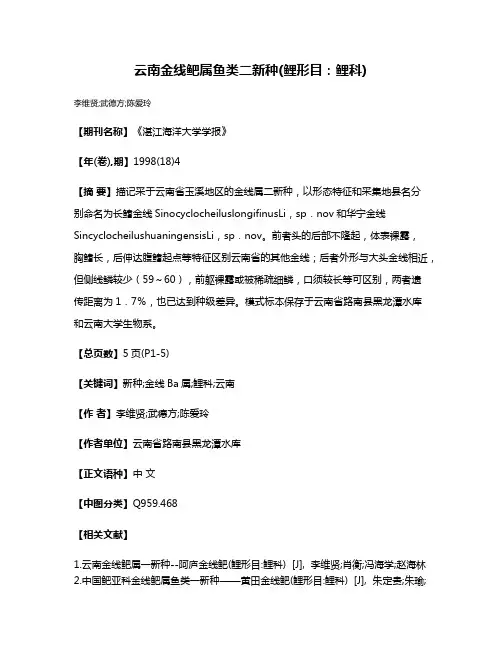
云南金线鲃属鱼类二新种(鲤形目:鲤科)
李维贤;武德方;陈爱玲
【期刊名称】《湛江海洋大学学报》
【年(卷),期】1998(18)4
【摘要】描记采于云南省玉溪地区的金线属二新种,以形态特征和采集地县名分
别命名为长鳍金线SinocyclocheiluslongifinusLi,sp.nov和华宁金线SincyclocheilushuaningensisLi,sp.nov。
前者头的后部不隆起,体表裸露,
胸鳍长,后伸达腹鳍起点等特征区别云南省的其他金线;后者外形与大头金线相近,但侧线鳞较少(59~60),前躯裸露或被稀疏细鳞,口须较长等可区别,两者遗
传距离为1.7%,也已达到种级差异。
模式标本保存于云南省路南县黑龙潭水库
和云南大学生物系。
【总页数】5页(P1-5)
【关键词】新种;金线Ba属;鲤科;云南
【作者】李维贤;武德方;陈爱玲
【作者单位】云南省路南县黑龙潭水库
【正文语种】中文
【中图分类】Q959.468
【相关文献】
1.云南金线鲃属一新种--阿庐金线鲃(鲤形目:鲤科) [J], 李维贤;肖衡;冯海学;赵海林
2.中国鲃亚科金线鲃属鱼类一新种——黄田金线鲃(鲤形目:鲤科) [J], 朱定贵;朱瑜;
蓝家湖
3.云南金线鲃属鱼类四新种(鲤形目:鲤科) [J], 李维贤
4.贵州金线鲃属鱼类一新种记述(鲤形目,鲤科),封四 [J], 周江;刘倩;王海霞;杨隆娇;赵大成;张天鸿;侯秀发
5.广西金线鲃属鱼类一新种(鲤形目:鲤科:鲃亚科) [J], 周石保;李国良
因版权原因,仅展示原文概要,查看原文内容请购买。
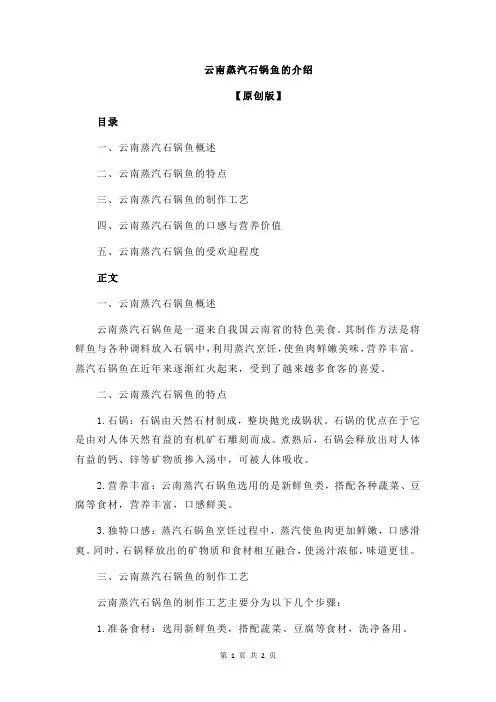
云南蒸汽石锅鱼的介绍【原创版】目录一、云南蒸汽石锅鱼概述二、云南蒸汽石锅鱼的特点三、云南蒸汽石锅鱼的制作工艺四、云南蒸汽石锅鱼的口感与营养价值五、云南蒸汽石锅鱼的受欢迎程度正文一、云南蒸汽石锅鱼概述云南蒸汽石锅鱼是一道来自我国云南省的特色美食。
其制作方法是将鲜鱼与各种调料放入石锅中,利用蒸汽烹饪,使鱼肉鲜嫩美味,营养丰富。
蒸汽石锅鱼在近年来逐渐红火起来,受到了越来越多食客的喜爱。
二、云南蒸汽石锅鱼的特点1.石锅:石锅由天然石材制成,整块抛光成锅状。
石锅的优点在于它是由对人体天然有益的有机矿石雕刻而成。
煮熟后,石锅会释放出对人体有益的钙、锌等矿物质掺入汤中,可被人体吸收。
2.营养丰富:云南蒸汽石锅鱼选用的是新鲜鱼类,搭配各种蔬菜、豆腐等食材,营养丰富,口感鲜美。
3.独特口感:蒸汽石锅鱼烹饪过程中,蒸汽使鱼肉更加鲜嫩,口感滑爽。
同时,石锅释放出的矿物质和食材相互融合,使汤汁浓郁,味道更佳。
三、云南蒸汽石锅鱼的制作工艺云南蒸汽石锅鱼的制作工艺主要分为以下几个步骤:1.准备食材:选用新鲜鱼类,搭配蔬菜、豆腐等食材,洗净备用。
2.准备石锅:将天然石材制成的石锅洗净,放入锅中加热,使其达到一定的温度。
3.烹饪:将准备好的食材放入石锅中,加入适量的水,盖上锅盖,利用蒸汽加热,使鱼肉和食材熟透。
4.调味:根据个人口味,加入适量的盐、味精等调味品,即可品尝美味的云南蒸汽石锅鱼。
四、云南蒸汽石锅鱼的口感与营养价值云南蒸汽石锅鱼口感鲜嫩,营养丰富。
鱼肉富含蛋白质、不饱和脂肪酸等营养成分,搭配蔬菜、豆腐等食材,使得这道菜肴更加丰富多样。
同时,石锅释放出的钙、锌等矿物质对人体有益,具有一定的抗衰老、抗癌、滋润滋养等功效。
五、云南蒸汽石锅鱼的受欢迎程度云南蒸汽石锅鱼近年来逐渐红火起来,受到了越来越多食客的喜爱。
许多餐馆纷纷推出这道特色菜肴,满足食客的需求。
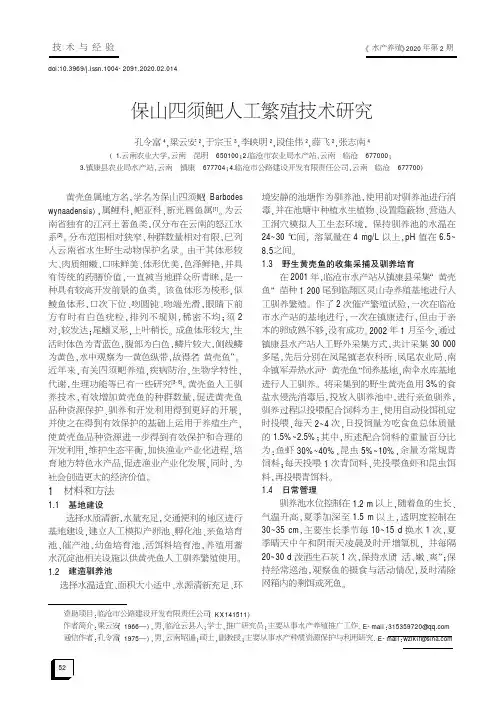
《水产养殖》2020年第2期资助项目:临沧市公路建设开发有限责任公司(KX141511)作者简介:梁云安(1966—),男,临沧云县人;学士,推广研究员;主要从事水产养殖推广工作.E-mail :315359720@ :孔令富(1975—),男,云南昭通;硕士,副教授;主要从事水产种质资源保护与利用研究.E-mail :wzlklf@ 保山四须鲃人工繁殖技术研究孔令富4,梁云安2,于宗玉3,李映明2,段佳伟2,薛飞2,张志南4(1.云南农业大学,云南昆明650100;2.临沧市农业局水产站,云南临沧677000;3.镇康县农业局水产站,云南镇康677704;4.临沧市公路建设开发有限责任公司,云南临沧677700)黄壳鱼属地方名,学名为保山四须鲃(Barbodes wynaadensis ),属鲤科,鲃亚科,新光唇鱼属[1]。
为云南省独有的江河土著鱼类,仅分布在云南的怒江水系[2]。
分布范围相对狭窄,种群数量相对有限,已列入云南省水生野生动物保护名录。
由于其体形较大、肉质细嫩、口味鲜美、体形优美,色泽鲜艳,并具有传统的药膳价值,一直被当地群众所青睐,是一种具有较高开发前景的鱼类。
该鱼体形为梭形,似鲮鱼体形,口次下位、吻圆钝、吻端光滑,眼睛下前方有时有白色疣粒,排列不规则,稀密不均;须2对,较发达;尾鳍叉形,上叶稍长。
成鱼体形较大,生活时体色为青蓝色,腹部为白色,鳞片较大,侧线鳞为黄色,水中观察为一黄色纵带,故得名“黄壳鱼”。
近年来,有关四须鲃养殖,疾病防治,生物学特性,代谢,生理功能等已有一些研究[3-6]。
黄壳鱼人工驯养技术,有效增加黄壳鱼的种群数量,促进黄壳鱼品种资源保护、驯养和开发利用得到更好的开展,并使之在得到有效保护的基础上运用于养殖生产,使黄壳鱼品种资源进一步得到有效保护和合理的开发利用,维护生态平衡,加快渔业产业化进程,培育地方特色水产品,促进渔业产业化发展,同时,为社会创造更大的经济价值。
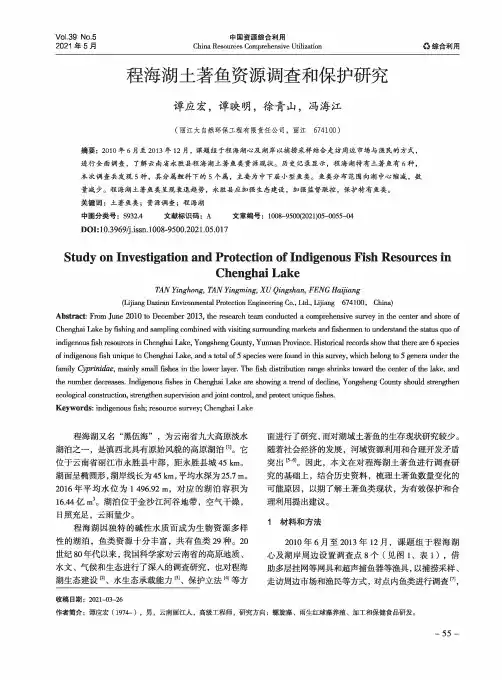
Vol.39No.5 2021年5月中国资源综合利用China Resources Comprehensive Utilization c综合利用程海湖土著鱼资源调查和保护研究谭应宏,谭映明,徐青山,冯海江(丽江大自然环保工程有限责任公司,丽江674100)摘要:2010年6月至2013年12月,课题组于程海湖心及湖岸以捕捞采样结合走访周边市场与渔民的方式,进行全面调查,了解云南省永胜县程海湖土著鱼类资源现状。
历史记录显示,程海湖特有土著鱼有6种,本次调查共发现5种,其分属鲤科下的5个属,主要为中下层小型鱼类。
鱼类分布范围向湖中心缩减,数量减少。
程海湖土著鱼类呈现衰退趋势,永胜县应加强生态建设,加强监督联控,保护特有鱼类。
关键词:土著鱼类;资源调查;程海湖中图分类号:S932.4文献标识码:A文章编号:1008-9500(2021)05-0055-04DOI:10.3969/j.issn.1008-9500.2021.05.017Study on Investigation and Protection of Indigenous Fish Resources inChenghai LakeTAN Yinghong,TAN Yingming,XU Qingshan,FENG Haijiang(Lijiang Daziran Environmental Protection Engineering Co.,Ltd.,Lijiang674100,China)Abstract:From June2010to December2013,the research team conducted a comprehensive survey in the center and shore of Chenghai Lake by fishing and sampling combined with visiting surrounding markets and fishermen to understand the status quo of indigenous fish resources in Chenghai Lake,Yongsheng County,Yunnan Province.Historical records show that there are6species of indigenous fish unique to Chenghai Lake,and a total of5species were found in this survey,which belong to5genera under the family Cyprinidae,mainly small fishes in the lower layer.The fish distribution range shrinks toward the center of the lake,and the number decreases.Indigenous fishes in Chenghai Lake are showing a trend of decline,Yongsheng County should strengthen ecological construction,strengthen supervision and joint control,and protect unique fishes.Keywords:indigenous fish;resource survey;Chenghai Lake程海湖又名“黑伍海”,为云南省九大高原淡水湖泊之一,是滇西北具有原始风貌的高原湖泊叫它位于云南省丽江市永胜县中部,距永胜县城45km。

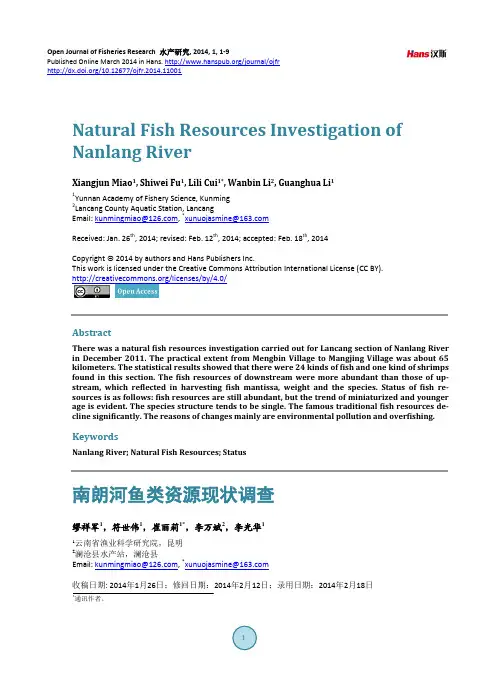
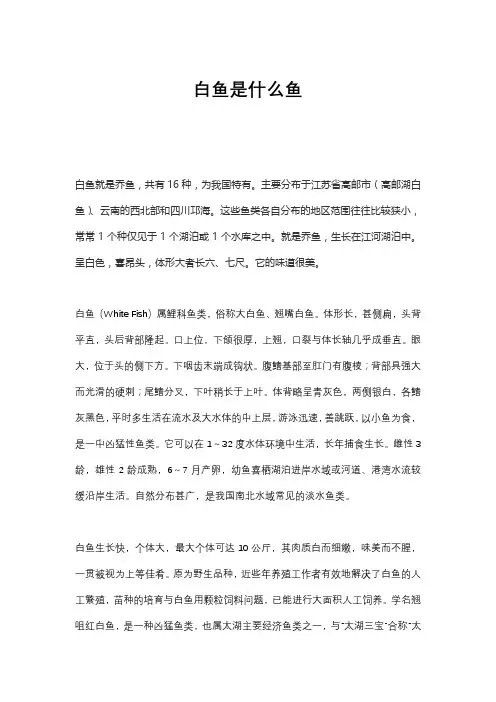
白鱼是什么鱼
白鱼就是乔鱼,共有16种,为我国特有。
主要分布于江苏省高邮市(高邮湖白鱼)、云南的西北部和四川邛海。
这些鱼类各自分布的地区范围往往比较狭小,常常1个种仅见于1个湖泊或1个水库之中。
就是乔鱼,生长在江河湖泊中。
呈白色,喜昂头,体形大者长六、七尺。
它的味道很美。
白鱼(White Fish)属鲤科鱼类,俗称大白鱼、翘嘴白鱼。
体形长,甚侧扁,头背平直,头后背部隆起。
口上位,下颌很厚,上翘,口裂与体长轴几乎成垂直。
眼大,位于头的侧下方。
下咽齿末端成钩状。
腹鳍基部至肛门有腹棱;背部具强大而光滑的硬刺;尾鳍分叉,下叶稍长于上叶。
体背略呈青灰色,两侧银白,各鳍灰黑色,平时多生活在流水及大水体的中上层,游泳迅速,善跳跃,以小鱼为食,是一中凶猛性鱼类。
它可以在1~32度水体环境中生活,长年捕食生长。
雌性3龄,雄性2龄成熟,6~7月产卵,幼鱼喜栖湖泊进岸水域或河道、港湾水流较缓沿岸生活。
自然分布甚广,是我国南北水域常见的淡水鱼类。
白鱼生长快,个体大,最大个体可达10公斤,其肉质白而细嫩,味美而不腥,一贯被视为上等佳肴。
原为野生品种,近些年养殖工作者有效地解决了白鱼的人工繁殖,苗种的培育与白鱼用颗粒饲料问题,已能进行大面积人工饲养。
学名翘咀红白鱼,是一种凶猛鱼类,也属太湖主要经济鱼类之一,与“太湖三宝”合称“太
湖四珍”。
少刺多肉,味道鲜美,营养价值较高。
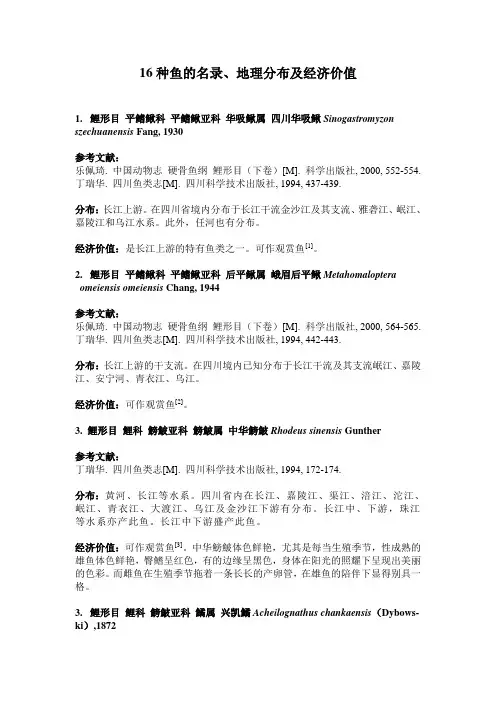
16种鱼的名录、地理分布及经济价值1.鲤形目平鳍鳅科平鳍鳅亚科华吸鳅属四川华吸鳅Sinogastromyzon szechuanensis Fang, 1930参考文献:乐佩琦. 中国动物志硬骨鱼纲鲤形目(下卷)[M]. 科学出版社, 2000, 552-554.丁瑞华. 四川鱼类志[M]. 四川科学技术出版社, 1994, 437-439.分布:长江上游。
在四川省境内分布于长江干流金沙江及其支流、雅砻江、岷江、嘉陵江和乌江水系。
此外,任河也有分布。
经济价值:是长江上游的特有鱼类之一。
可作观赏鱼[1]。
2.鲤形目平鳍鳅科平鳍鳅亚科后平鳅属峨眉后平鳅Metahomaloptera omeiensis omeiensis Chang, 1944参考文献:乐佩琦. 中国动物志硬骨鱼纲鲤形目(下卷)[M]. 科学出版社, 2000, 564-565.丁瑞华. 四川鱼类志[M]. 四川科学技术出版社, 1994, 442-443.分布:长江上游的干支流。
在四川境内已知分布于长江干流及其支流岷江、嘉陵江、安宁河、青衣江、乌江。
经济价值:可作观赏鱼[2]。
3. 鲤形目鲤科鰟鮍亚科鰟鮍属中华鰟鮍Rhodeus sinensis Gunther参考文献:丁瑞华. 四川鱼类志[M]. 四川科学技术出版社, 1994, 172-174.分布:黄河、长江等水系。
四川省内在长江、嘉陵江、渠江、涪江、沱江、岷江、青衣江、大渡江、乌江及金沙江下游有分布。
长江中、下游,珠江等水系亦产此鱼。
长江中下游盛产此鱼。
经济价值:可作观赏鱼[3]。
中华鰟鮍体色鲜艳,尤其是每当生殖季节,性成熟的雄鱼体色鲜艳,臀鳍呈红色,有的边缘呈黑色,身体在阳光的照耀下呈现出美丽的色彩。
而雌鱼在生殖季节拖着一条长长的产卵管,在雄鱼的陪伴下显得别具一格。
3.鲤形目鲤科鰟鮍亚科鱊属兴凯鱊Acheilognathus chankaensis(Dybows-ki),1872参考文献:陈宜瑜 . 中国动物志硬骨鱼纲鲤形目(中卷)[M]. 科学出版社1998, 433-435.丁瑞华. 四川鱼类志[M]. 四川科学技术出版社, 1994, 187-188.分布:分布于长江、珠江、韩江、黄河、黑龙江等水系。
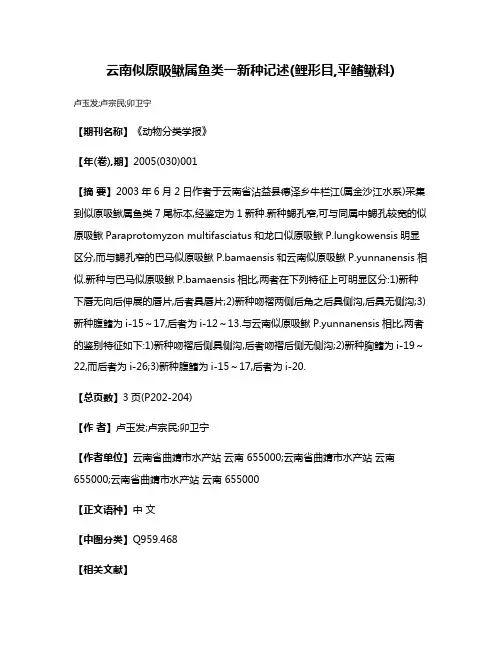
云南似原吸鳅属鱼类一新种记述(鲤形目,平鳍鳅科)卢玉发;卢宗民;卯卫宁【期刊名称】《动物分类学报》【年(卷),期】2005(030)001【摘要】2003年6月2日作者于云南省沾益县德泽乡牛栏江(属金沙江水系)采集到似原吸鳅属鱼类7尾标本,经鉴定为1新种.新种鳃孔窄,可与同属中鳃孔较宽的似原吸鳅Paraprotomyzon multifasciatus和龙口似原吸鳅P.lungkowensis明显区分,而与鳃孔窄的巴马似原吸鳅P.bamaensis和云南似原吸鳅P.yunnanensis相似.新种与巴马似原吸鳅P.bamaensis相比,两者在下列特征上可明显区分:1)新种下唇无向后伸展的唇片,后者具唇片;2)新种吻褶两侧后角之后具侧沟,后具无侧沟;3)新种腹鳍为i-15~17,后者为i-12~13.与云南似原吸鳅P.yunnanensis相比,两者的鉴别特征如下:1)新种吻褶后侧具侧沟,后者吻褶后侧无侧沟;2)新种胸鳍为i-19~22,而后者为i-26;3)新种腹鳍为i-15~17,后者为i-20.【总页数】3页(P202-204)【作者】卢玉发;卢宗民;卯卫宁【作者单位】云南省曲靖市水产站云南 655000;云南省曲靖市水产站云南655000;云南省曲靖市水产站云南 655000【正文语种】中文【中图分类】Q959.468【相关文献】1.爬岩鳅属鱼类一新种(鲤形目:平鳍鳅科) [J], 唐文乔;王大忠;余涛2.原缨口鳅属一新种(鲤形目:平鳍鳅科) [J], 张春光;赵亚辉3.云南牛栏江云南鳅属鱼类二新种记述(鲤形目,爬鳅科,条鳅亚科) [J], 安莉;刘柏松;李维贤4.中国爬岩鳅属鱼类一新种记述(鲤形目,平鳍鳅科) [J], 陈自明;黄艳飞;杨君兴5.中国浙江缨口鳅属一新种(鲤形目,平鳍鳅科,腹吸鳅亚科) [J], 王火根;范忠勇;陈莹因版权原因,仅展示原文概要,查看原文内容请购买。
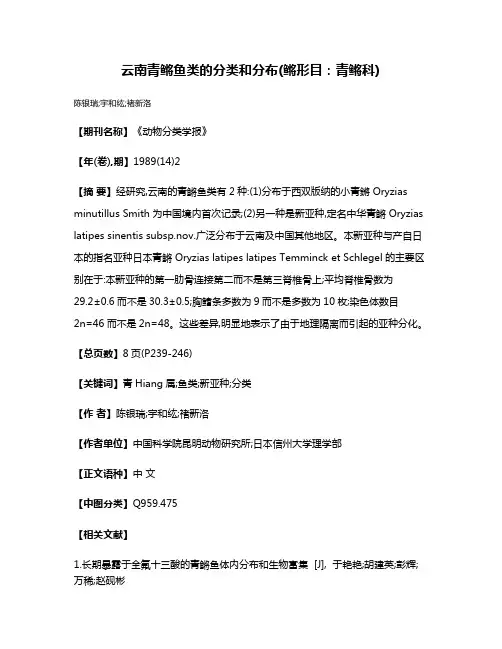
云南青鳉鱼类的分类和分布(鳉形目:青鳉科)陈银瑞;宇和纮;褚新洛【期刊名称】《动物分类学报》【年(卷),期】1989(14)2【摘要】经研究,云南的青鳉鱼类有2种:(1)分布于西双版纳的小青鏘 Oryzias minutillus Smith为中国境内首次记录;(2)另一种是新亚种,定名中华青鳉 Oryzias latipes sinentis subsp.nov.广泛分布于云南及中国其他地区。
本新亚种与产自日本的指名亚种日本青鳉 Oryzias latipes latipes Temminck et Schlegel的主要区别在于:本新亚种的第一肋骨连接第二而不是第三脊椎骨上;平均脊椎骨数为29.2±0.6而不是30.3±0.5;胸鳍条多数为9而不是多数为10枚;染色体数目2n=46而不是2n=48。
这些差异,明显地表示了由于地理隔离而引起的亚种分化。
【总页数】8页(P239-246)【关键词】青Hiang属;鱼类;新亚种;分类【作者】陈银瑞;宇和纮;褚新洛【作者单位】中国科学院昆明动物研究所;日本信州大学理学部【正文语种】中文【中图分类】Q959.475【相关文献】1.长期暴露于全氟十三酸的青鳉鱼体内分布和生物富集 [J], 于艳艳;胡建英;彭辉;万稀;赵砚彬2.广东淡水鱼类弓背青鳉分类形态性状再描述 [J], 张方方;姜昊辰;金锦锦;仇玉萍;陈国柱3.宁夏鳉形目鱼类1新纪录种——青鳉 [J], 赵红雪4.中国鱼类名录Ⅶ.银汉鱼目、颌针鱼目、鳉形目、鲻形目、奇金眼鲷目、金眼鲷目、海鲂目、刺鱼目、合鳃目 [J], 李明德;5.中国3种青鳉鱼类初孵仔鱼发育与形态比较 [J], 陈国柱;金锦锦;肖乔芝;仇玉萍因版权原因,仅展示原文概要,查看原文内容请购买。
云南古鱼类概述
陈银瑞;崔桂华
【期刊名称】《四川动物》
【年(卷),期】1989(008)001
【总页数】3页(P27-29)
【作者】陈银瑞;崔桂华
【作者单位】不详;不详
【正文语种】中文
【中图分类】Q915.862
【相关文献】
1.古东方文化与古西方文化的怨恨主题学概述 [J], 王明科;张海燕;姑丽娜尔·吾甫力
2.广西云南鳅属鱼类一新种——靖西云南鳅 [J], 朱瑜;杜丽娜;陈小勇;杨君兴
3.云南鱼类三新纪录及驮娘江鱼类的区系存在度分析 [J], 杜丽娜;黄艳飞;陈小勇;杨君兴
4.一个绝灭的古鱼类类群——盾皮鱼类 [J], 刘升;赵文金
5.气候变化对部分北极淡水鱼类和溯河产卵鱼类的影响概述 [J], James
D.Reist;Frederick J.Wrona;Terry D.Prowse;Michael Power;J.Brian Dempson;Jacqelynne R.King;Richard J.Beamish;岳浩
因版权原因,仅展示原文概要,查看原文内容请购买。
生物资源2019,41(3):280~280Biotic Resources澜沧江激流勇士——无斑褶鮡朱挺兵(中国水产科学研究院长江水产研究所,农业农村部淡水生物多样性保护重点实验室,湖北武汉430223)无斑褶鮡(Pseudecheneis immaculatus )属鲇形目,鮡科,褶鮡属,为澜沧江上游特有的小型鱼类。
具体的分布记录包括西藏自治区芒康县[1]和云南省德钦县、维西县、兰坪县、云龙县[2~4]等地。
体较细长,尾柄细壮有力;吻端圆;眼小,背位;口小,下位;须4对;背鳍无硬刺;胸部具发达的吸着器,一般有横褶15~16条;体色均一,如同红泥水色;喜居流水环境,一般分布于水体底层,借口部、吸着器及腹鳍贴附水底岩石表面,胸鳍并不接触石面,其作用在于平衡和支持身体[1]。
我国鮡科鱼类至今已记录12属64种[5],其中大部分种类分布于我国西南地区的偏僻江河中。
这也导致了目前对鮡科鱼类的研究大都停留在分布记录上,而其他方面的研究资料几近空白。
鮡科鱼类繁殖力低,生长缓慢,对环境要求极高,因此种群也十分脆弱。
由于其肉质鲜美、野生资源量小,市场上鮡科鱼类的售价一般为400~2000元/kg 不等,是普通鱼类的数倍甚至数十倍。
为追求高额利益,非法捕捞鮡科鱼类的现象非常猖獗,导致野生资源量迅速下降。
同时,鮡科鱼类对河流环境水文特征和水环境细微变化极为敏感。
近年来,随着我国西南地区水电开发的日益加剧,河道阻隔、流速减缓等水文形势变化对鮡科鱼类的生存带来了越来越大的威胁。
根据蒋志刚等[6]的评估,无斑褶鮡属易危物种(vulnerable species ),并已被列入中国脊椎动物红色名录。
为有效保护物种,迫切需要加强鮡科鱼类个体发育、食性、繁殖、生态习性等基础生物学方面的研究,同时加快推进人工驯养和繁育等物种保护技术攻关。
参考文献[1]李斌,岳兴建,王志坚.西藏鮡科鱼类一新纪录种—无斑褶鮡[J].重庆师范大学学报,2010,27(2):18-19.[2]褚新洛,陈银瑞.云南鱼类志(下册)[M].北京:科学出版社,1990:198-199.[3]徐伟毅,缪祥军,邱家荣,等.怒江傈僳族自治州的鱼类调查[J].水生态学杂志,2009,2(3):37-41.[4]郭祖锋,李林,贺伟平,等.澜沧江上游鱼类资源研究[J].现代农业科技,2014(14):228,237.[5]肖海,代应贵,张晓杰,等.我国鮡科鱼类种质资源研究进展[J].广东农业科学,2010,37(8):180-182,198.[6]蒋志刚,江建平,王跃招,等.中国脊椎动物红色名录[J].生物多样性,2016,24(5):500-551.□丞丞丞丞丞丞丞丞丞丞丞丞丞丞丞丞丞丞丞丞丞丞丞丞丞丞丞丞丞丞丞丞丞丞丞丞封面图片介绍。
㊀㊀第40卷㊀第1期㊀吉首大学学报(自然科学版)V o l.40㊀N o.1㊀㊀㊀㊀2019年1月J o u r n a l o f J i s h o uU n i v e r s i t y(N a t u r a l S c i e n c eE d i t i o n)J a n.2019㊀㊀文章编号:10072985(2019)01006103云南金线鲃属一新种版纳金线鲃∗李维贤1,李春青2,陈泓宇2(1.云南省石林县黑龙潭水库,云南石林652200;2.云南大学生命科学学院,云南昆明650091)㊀㊀摘㊀要:描记采于云南省西双版纳勐腊县罗梭江的金线鲃属一新种,命名版纳金线鲃S i n o c y c l o c h e i l u s b a n n a e n s i s s p.n o v.,该新种曾被误订为狭孔金线鲃S.a n g u s t i p o r u s Z h e n g e t X i e1985,但背鳍条i i i8v s i i i7,侧线鳞47v s68~89两特征可明显区别.新种外形更像粗壮金线鲃S.r o b u s t u s C h e ne tZ h a o1988,但背鳍条i i i8v s i i i7,侧线鳞47v s72亦可区别.关键词:新种;金线鲃属;西双版纳;罗梭江;云南省中图分类号:Q959.46+8㊀㊀㊀㊀㊀㊀㊀文献标志码:A D O I:10.13438/j.c n k i.j d z k.2019.01.015上世纪80年代的1984年5月5日,云南大学生物系教师曾祖启等带领学生在西双版纳实习时,在勐腊县勐仑区(现勐仑镇)的罗梭江中捕到一批鱼类标本.其中有一尾金线鲃,曾被该系何纪昌先生鉴定为狭孔金线鲃S.a n g u s t i p o r u s,但未正式报道.后经笔者检视,发现该种与已记录的种[14]不同,应认定为一新种,命名版纳金线鲃S i n o c y c l o c h e i l u s b a n n a e n s i s s p.n o v..由于该种是首次在澜沧江水系发现,因此一直未曾发表,希望能再次采到一部分标本.作者李维贤曾在2000年到版纳考察,未采集到标本;李春青在2016年及2017年2次到勐仑考察,亦未采集到标本.30余年沧海桑田,生态环境变化巨大,但考察中发现罗梭江确有石灰岩河段,勐仑亦有民间石灰岩作坊,说明该地区具备金线鲃生息分布的条件,现决定将该种正式命名发表.新种版纳金线鲃S i n o c y c l o c h e i l u s b a n n a e n s i s s p.n o v.如图1所示.图1㊀版纳金线鲃F i g.1㊀S i n o c y c l o c h e i l u sB a n n a e n s i s L i,L i e t C h e nS p.N o v.∗收稿日期:20181108基金项目:国家自然科学基金资助项目(31560111)作者简介:李维贤(1937 ),男,云南石林人,研究员,主要从事中国特产鱼类金线鲃和洞穴生物学研究;李春青(1979 ),男,云南师宗人,云南大学生命科学学院实验师,本文共同第一作者,主要从事鱼类遗传与进化研究.26吉首大学学报(自然科学版)第40卷模式标本1尾,编号84050508,体长87mm,全长106mm,1984年5月5日采于云南省西双版纳勐腊县勐仑区(现勐仑镇)罗梭江,海拔550m,东经101ʎ14ᶄ,北纬21ʎ55ᶄ.标本保存在云南省石林县黑龙潭水库.背鳍条i i i8,臀鳍条i i5,胸鳍条i13,腹鳍条i9,尾鳍分支鳍条16;侧线鳞47;右侧第一鳃弓鳃耙2+5;下咽齿3行2.3.4/4.3.2.体长为体高的3.48倍,头长的3.22倍,尾柄长的4.35倍,尾柄高的7.91倍;头长为吻长的3.00倍,眼径的6.75倍,眼间距的3.89倍;尾柄长为尾柄高的1.82倍.体延长,侧扁;头短小,略尖,头后急剧隆起;体背呈一弓形,背鳍起点前为体最高点.头长略大于体高;吻尖而短,吻长加眼径略小于眼后头长;两鼻孔在吻端与眼前缘中点上,吻端略隆起;口下位,浅马蹄形,两对口须中等发达.背鳍起点略在腹鳍起点之前,至吻端的距离大于至尾鳍基的距离;背鳍前长为体长的54.23%,最末不分枝鳍条为硬刺,后缘有锯齿.胸鳍后伸接近腹鳍起点,腹鳍后伸不达肛门,肛门紧靠臀鳍起点,臀鳍后伸远不达尾鳍基,约达至尾鳍基距离的1/2.尾鳍叉形,外侧最长鳍条为内侧最短鳍条的1.42倍.侧线完全,走向略平直;侧线鳞明显大于体鳞;体表上半身裸露无鳞或体鳞隐于皮下,下半身在侧线鳞下有明显鳞片;侧线下鳞为3V,胸腹部裸露或鳞片隐于皮下.体色:整个标本体色褚褐色,背部较深,沿体背两侧各有一行明显大型黑斑.本种外形接近狭孔金线鲃,但有下列特征可明显区别:(1)背鳍条i i i8v s i i i7;(2)侧线鳞47v s68~89;(3)大型黑斑点分布于体背两侧v s分布于侧线上.本种外形与粗壮金线鲃也相似,但背鳍i i i8v s i i i7,侧线鳞47v s72,以及鳃耙2+5v s3亦明显区别(表1,图2).表1㊀版纳金线鲃㊁狭孔金线鲃与粗壮金线鲃性状比较T a b l e1㊀M o r p h o m e t r i c s o f S.B a n n a e n s i s,S.A n g u s t i p o r u s a n d S.R o b u s t u s性状版纳金线鲃S.b a n n a e n s i s狭孔金线鲃S.a n g u s t i p o r u s粗壮金线鲃S.r o b u s t u s 标本数量1191采集地西双版纳罗梭江贵州兴义㊁兴仁㊁贞丰贵州黄泥河水系澜沧江南盘江㊁北盘江南盘江体长/mm8746~109170背鳍i i i8i i i7i i i7臀鳍i i5i i i5i i5胸鳍i13i13~15i14腹鳍i9i i7~8i i8尾鳍分支鳍条16侧线鳞476829~3516~20V8972鳃耙2+56~83体长/体高(倍)3.483.6~4.84.0体长/头长(倍)3.223.5~4.04.5体长/尾柄长(倍)4.354.1~4.84.2体长/尾柄高(倍)7.917.3~10.49.2头长/吻长(倍)3.002.8~3.52.4头长/眼径(倍)6.753.7~5.46.3头长/眼间距(倍)3.892.4~3.22.7尾柄长/尾柄高(倍)1.82㊀㊀㊀㊀注:狭孔金线鲃与粗壮金线鲃的性状数据引自文献[1].图2㊀狭孔金线鲃和粗壮金线鲃F i g.2㊀S .A n g u s t i p o r u s a n d S .R o b u s t u s ㊀㊀致谢:原云南大学生物系教师曾祖启先生采集标本并详细介绍采集地生态环境,在此致谢.参考文献:[1]乐佩琦.中国动物志 硬骨鱼纲 鲤形目(下卷)[M ].北京:科学出版社,2000.[2]赵亚辉,张春光.中国特有金线鲃属鱼类:物种多样性㊁洞穴适应㊁系统演化和动物地理[M ].北京:科学出版社,2009.[3]张春光,赵亚辉,等.中国内陆鱼类物种与分布[M ].北京:科学出版社,2016.[4]陈小勇.云南鱼类名录[J ].动物学研究,2013,34(4):281343.AN e wS pe c i e s of S i n o c y c l o c h e i l u s f r o m Y u n n a n ,C h i n a :S i n o c yc l o c h e i l u sB a n n a e n s i s L IW e i x i a n 1,L IC h u n q i n g 2,C H E N H o n g yu 2(1.H e i l o n g t a nR e s e r v o i rA d m i n i s t r a t i o no f S h i l i nC o u n t y,S h i l i n652200,Y u n n a nC h i n a ;2.S c h o o l o fL i f eS c i e n c e s ,Y u n n a nU n i v e r s i t y ,K u n m i n g 650091,C h i n a )A b s t r a c t :T h i s p a p e r d e s c r i b e s an e ws p e c i e so f t h e g e n u s S i n o c y c l o c h e i l u s ,S .b a n n a e n s i s s p .n o v .c o l Gl e c t e d f r o mt h eL u o s u o j i a n g (101ʎ14ᶄN ,21ʎ55ᶄE )i nX i s h u a n g b a n n a o fY u n n a n ,C h i n a .T h e n e ws p e c i e s i s s i m i l a r t o S .a n g u s t i po r u s Z h e n g e tX i e (1985)b u t d i f f e r s f r o mt h e l a t t e r i n :①D.i i i G8(v s .i i i G7);②l a t Ge r a l l i n e s c a l e s 47(v s .68~89).T h i s n e ws pe c i e s i s a l s o s i m i l a rw i t h S .r o b u s t u s C h e n e t Z h a o (1988),b u t i t c a nb e d if f e r e n t i a t e d f r o m S .r o b u s t u s b y D.i i i G8(v s .i i i G7),l a t e r a l l i n e s c a l e s 47(v s .72).K e y wo r d s :n e ws p e c i e s ;S i n o c y c l o c h e i l u s ;X i s h u a n g b a n n a ;L u o s u o j i a n g ;Y u n n a nP r o v i n c e (责任编辑㊀易必武)36第1期㊀㊀㊀㊀㊀㊀㊀㊀㊀㊀㊀㊀㊀李维贤,等:云南金线鲃属一新种 版纳金线鲃。
云南鱼类名录鱇浪白鱼:Anabarilius grahami俗称:白鱼、抗浪鱼。
分类:鲤形目,鲤科,鲌亚科,白鱼属。
产地:仅产于云南抚仙湖。
特征:体细圆而不显着侧扁,整个身体轮廓成一狭长的纺锤形,背部平直,腹圆呈浅弧形。
吻尖,口亚上位,下颌前端的突起与上颌的凹陷不甚显着,无须。
腹棱自腹鳍基部逐渐隆起向后延伸至肛门。
鳞小,在腹鳍基具两枚相互重叠的细长腋鳞,侧线在胸鳍上方徐徐向下弯折。
体呈银白色,背部较暗;鳍为灰白色,眼上下缘红色。
个体小而纤细。
习性:喜水质新鲜、含氧量较高的水域环境。
游泳迅速,抗风浪能力强,为中上层鱼类。
平时栖居开阔的敞水面。
主食枝角类、桡足类、丝状藻和水生昆虫。
现状:鱇浪白鱼为抚仙湖的特产鱼类,曾是该湖主要的经济鱼类,占全湖渔产量的60%以上。
80年代中期,由于星云湖引进银鱼,其从与抚仙湖相通的隔河大量涌入,银鱼的食性与鱇浪白鱼相似,占据了鱇浪白鱼的生态位,再加之大量使用小规格丝网捕鱼、酷鱼滥捕、过量捕捞、水质环境恶化,导致数量急剧下降,接近濒危的边缘,市场价格一度攀升至500-2000元每公斤,全湖渔产量不足数百公斤。
1999年,中国科学院昆明动物研究所通过对鱇浪白鱼进行人工授精孵化、人工饵料培育和筛选、人工驯养繁殖及其鱼病防治等一系列研究使这一珍贵鱼种得以保护,为抚仙湖该鱼种的增殖回放产生了积极的效果。
价值:鱇浪白鱼是中国特有鱼类,为云南省四大名鱼之一,其肉细味鲜美,刺软,鳞小,香味可口,腌制成干品,放置一年不变味。
可供烧、烤、煎、炸食用,别具风味,为鱼中的上等佳品。
滇池金线鲃:Sinocyclocheilus grahami俗称:金线鱼。
分类:鲤形目,鲤科,鲃亚科,金线鲃属。
产地:仅产于云南滇池。
特征:体侧扁,头背面平直,中部稍下凹,头后背部隆起。
吻端尖,口次下位,上颌稍长于下颌。
眼中等大,在头侧的前上位。
须2对,吻须和口角须等长或前者稍短。
全身被鳞,呈覆瓦状。
鳞圆形,侧线鳞较上下鳞大,游动时,在阳光下褶褶发光,“金线鱼”的名字由此而来。
侧线完全,头背部及侧线上下有不规则的黑色斑块,疏密程度因个体而异。
习性:喜清泉流水,营半穴居生活,通常夜间到洞外觅食。
主食浮游动物、小鱼、小虾和水生昆虫等,兼食少量丝状藻和高等植物碎屑。
现状:滇池金线鲃为滇池特有鱼类。
上个世纪五六十年代在滇池水体为主要经济鱼类之一,近30年来,由于环境污染、水质恶化、盲目引种、过度捕捞等原因,滇池金线鲃已从滇池湖体消失,在滇池水域难觅踪迹,仅少量存在于滇池周边未受污染的溪流、龙潭、水库中。
2004年中国科学院昆明动物研究所经过前期的调查,在基本了解滇池金线鲃生物习性的基础上,从滇池上游溪流引种滇池金线鲃200尾,进行人工繁殖研究。
研究人员克服滇池金线鲃饲养、催产和孵化各环节的困难,成功攻克滇池金线鲃人工繁殖的技术,至2008年,项目组成功繁殖出滇池金线鲃二代仔鱼10万余尾。
价值:金线鱼属于国家Ⅱ级保护野生动物, 为中国濒危特有鱼类,也是云南特有的一种经济鱼类,属国内名贵鱼类,它与大头鲤、大理弓鱼、抗浪鱼一起,誉为云南四大名鱼。
早在明代《大明一统志》中,就有金线鱼肉质细嫩,味道鲜美的记述。
具有滋阴调元、暖肾填精的功效,主治虚劳损伤、肾虚滑精等症。
品质优良,肉质鲜嫩,营养元素丰富,味道鲜美。
金线鱼每百克肉含蛋白质18.1克,脂肪15克,肉质细腻,刺软鳞细,肉质鲜美,可用作煎、炸、红烧、清汤等多种食用方法,特别经清蒸后,有形有色,金线犹存,原汁原味,为鱼中的上等佳品。
有极高的经济、观赏、美食价值,在国内外素有盛名。
大头鲤:Cyprinus pellegrini俗名:大头鱼、碌鱼。
分类:鲤形目,鲤科,鲤亚科,鲤属。
产地:生活于云南省的星云湖和杞麓湖。
特征:大头鲤的体形与鲤鱼十分相似,但头部较宽大,所以得名“大头鱼”。
其头长大于体高和背鳍基长,为体长的1/3,头背宽而平坦。
无须,或有一对较短的口角须(若与其他鲤鱼杂交后,其后代口角须变的较为明显)。
尾柄细长,尾鳍呈深叉状,鳃耙排列甚细密。
鳞片较大,侧线完全。
生活时,背部青灰色,腹部银白色。
体侧反射黄绿色光彩,偶鳍及臀鳍均为淡黄色。
尾鳍亦呈淡黄色,下叶稍显红色习性:喜水深而水质较清澈的水体,为中上层鱼类。
性活跃,游泳迅速,对恶劣环境耐受力差。
食性单一,均以浮游动物为主,兼食部分浮游植物。
产卵期较长,为每年的4-9月,多集中在5、6月份,分批产卵。
现状:在20世纪50-60年代,大头鲤主产于江川的星云湖和通海的杞麓湖,在当地渔产量中占有很大优势,具有极高的经济价值。
70年代后数量锐减,现在原产地数量稀少,价值昂贵。
偶见种类大多也是与元江鲤杂交的后代。
究其消亡的原因与两湖水质污染、引进草、鲢、鳙等经济鱼类相关。
引进大量的草鱼蚕食了湖泊中的水草,破坏了大头鲤的产卵场;引进的鳙鱼与大头鲤食性相近,但滤食机能较之更为完善;加之过度捕捞,从而使大头鲤的生存空间和饵料收到威胁,致使大头鲤资源日趋枯竭,成为珍稀濒危鱼类。
2006年中国科学院昆明动物研究所与云南欧震贸易公司制定了抢救保育提纯复壮大头鲤的计划,在江川等地建立了人工繁殖研究基地,开展提纯保育纯种亲本大头鲤的研究工作。
价值:大头鲤为国家Ⅱ级保护动物,我国特有种,亦是云南四大名鱼之一。
因其肉细嫩,含脂量高,味美,营养丰富,颇受人们欢迎。
在中医学上还可将其入药,具有滋补、祛风的疗效。
云南裂腹鱼Schizothorax yunnanensis地方名面鱼外部形态特征云南裂腹鱼,体狭长,稍侧扁。
一般长约15厘米,大者可至30厘米。
头呈锥形,口下位。
下唇肉质,后缘游离,具左右2叶,无明显的中叶,唇后沟不连续,下颌内侧微角质化,但不形成锐利的边缘。
须2对,几等长,较眼径略长或相等。
吻须的末端到达鼻孔后缘的下方;颉须末端达眼球中部的下方。
下咽齿3行,细长,顶端弯曲。
鳞细小,腹部自鳃峡至胸鳍末端下方裸露无鳞;侧线鳞较体鳞为大,臀鳍和-两侧均有大鳞。
背鳍Ⅲ8,不分枝鳍条的硬刺后缘有锯齿。
臀鳍Ⅱ5。
体背和侧面青灰色,具有多数不规则的小黑斑点,腹部银白色。
生活习性自然条件下,喜生活于水质清新的江河、水库、湖泊中。
人工驯养条件下,能在池塘中饲养。
属中小型亚冷水性鱼类,云南特有种。
现数量很少。
繁殖雄性成熟年龄:2-4;雌性成熟年龄:3-6;性成熟体长:雌鱼216,雄鱼150;性成熟体重:雌鱼200,雄鱼60;绝对怀卵量:1656-33855(10980);相对怀卵量:15.53-48.24(24.43);产卵水温:14-17;产卵类型:沉性兼粘性;性腺成熟周期:12;卵特性:沉性兼粘性;产卵习性:石砾上产卵。
滇池高倍鲫鱼Carassius auratus滇池高倍鲫鱼是滇池土着鱼类,上世纪70年代中期在滇池及其水系自然形成的三倍体鲫鱼种群,系全雌性群体,行孤雌繁殖,保持了品种性状的稳定和群体生存延续而成为鲫鱼家族的新秀。
滇池高背鲫鱼是我省名贵土着鱼类,在我省滇池、星云湖、程海、牛栏江、金沙江等江河湖泊中均有一定的种群数量,有充足的种质资源,属滇池国家级水产种质资源保护区保护对象。
滇池高背鲫鱼体形为纺锤型,体长为体高的2.28倍,体色银灰,背部色较深,腹部色较浅。
喜集群,特别喜在底质肥沃的浅水带栖息和摄食。
属杂食性鱼类,主要以腐殖质、营养碎屑为食,可清洁水底杂质,还摄食部分藻类,对水体有较好的净化作用。
高背鲫鱼适应性较广,能在湖泊、水库、池塘、坝塘等水域生长,最适生长水温24-30℃。
该鱼生长迅速、繁殖力强、抗病力强、个体较大、易于养殖,一般二龄可达到300克-500克,三龄个体长到1000克以上的也常见,最大个体3000克。
滇池高背鲫鱼肉味鲜美,肉质细嫩,极为可口。
鲫鱼营养价值极高,每百克肉含蛋白质13克、脂肪 11克,并含有大量的钙、磷、铁等矿物质,特点是营养素全面,含糖分多,脂肪少,所以吃起来既鲜嫩又不肥腻,还有点甜丝丝的感觉。
高背鲫鱼所含的蛋白质质优、齐全,容易消化吸收,是肝肾疾病、心脑血管疾病患者的良好蛋白质来源。
经常食用,可补充营养,增强抗病能力。
高背鲫鱼有健脾利湿、和中开胃、活血通络、温中下气之功效。
对脾胃虚弱、水肿、溃疡、气管炎、哮喘、糖尿病有很好的滋补食疗作用。
民间常给产后妇女炖食鲫鱼汤,既可以补虚,又有通乳催奶的作用。
先天不足,后天失调,以及手术后、病后体虚形弱者,经常吃一些高背鲫鱼是很有益的。
肝炎、肾炎、高血压、心脏病、慢性支气管炎等疾病的患者也可以经常食用,以补营养,增强抗病能力。
高背鲫鱼子能补肝养目,鲫鱼脑有健脑益智作用。
适用所有人群,医典有云:“与病无碍,诸鱼中惟此可常食。
”食用量每餐40克。
滇池高背鲫鱼做法有红烧鲫鱼、清蒸鲫鱼、清汤鲫鱼、油炸鲫鱼(个体较小,规格在100克以下适用)、腌制鲫鱼、酸辣鲫鱼、煎炖鲫鱼、晒制干鱼等。
其中清蒸、清汤营养效果最佳,冬令时节食之最佳。
平素用鲫鱼与豆腐搭配炖汤营养最佳。
丝尾鳠Mystus wyckioides Chaux et Fang又称白须公鱼,马来西亚称Baung。
生物学特性1.外部形态:头部扁平呈圆锥形,躯干部圆柱形,背部较高。
背鳍棘后缘有倒刺,胸鳍棘前缘有锯齿,后缘锯齿粗大。
有脂鳍,鳍基与臀鳍相当。
尾鳍分叉,上叶延长成丝状。
有须4对,包括鼻须1对,上颌须1对,下颌须2对,其中上颌须很长,末端超过腹鳍伸达臀鳍附近。
体裸露无鳞,侧线完全。
体色发灰,腹部银白,体表及鳍上均无黑斑。
2.生活习性:丝尾鳠属热水性鱼类,生活温度为15℃~37℃,最适温度26℃~32℃,低于15℃明显不适,14℃鱼体失去平衡。
pH6.5~8.5,对水中溶解氧要求不高。
属底层鱼类,集群特性明显,较易起捕。
在马来西亚,丝尾鳠通常分布在河口受潮汐影响的河段直到上游的缓流水域,也栖息于稻田附近的渠道。
喜欢栖息于不是非常清澈的水域,水深达2~4米。
没有泥浆的湖泊或水坝的岸边水域是它们的首选栖身地。
该鱼为动物性为主的杂食性,天然条件下,幼鱼以浮游生物为食,成鱼则以幼虫、小鱼、甲壳类、水生昆虫、水蚯蚓和有机碎片等为食。
人工条件下,可摄食各种商品饲料及其配合饲料。
3.生长、繁殖:长速较快,个体较大,当年苗种可长至150g以上,天然水域常见个体0.4~2.5Kg。
雌鱼32.5~35.5cm,雄鱼35.5~38.5cm开始性成熟。
在马来西亚,丝尾鳠共有两个主要繁殖期,首阶段为2~4月,第二阶段为8~11月。
胭脂鱼Myxocyprinus asiaticus别????称黄排、血排、粉排、食底泥鱼、一帆风顺二名法Myxocyprinus asiaticus界动物界门脊索动物门亚????门脊椎动物亚门纲辐鳍鱼纲亚????纲新鳍亚纲目鲤形目科吸口鲤科亚????科胭脂鱼亚科属胭脂鱼属种胭脂鱼分布区域长江水系英文名Chinese sucker外形特征胭脂鱼体侧扁,背部在背鳍起点处特别隆起。